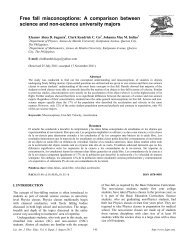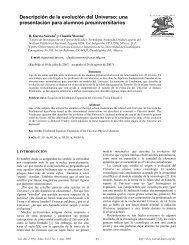Precession and nutation visualized [PDF]
Precession and nutation visualized [PDF]
Precession and nutation visualized [PDF]
You also want an ePaper? Increase the reach of your titles
YUMPU automatically turns print PDFs into web optimized ePapers that Google loves.
<strong>Precession</strong> <strong>and</strong> <strong>nutation</strong> <strong>visualized</strong>L. J. Villegas Vicencio 1 , M. J. Larrañaga Fu 2 , J. R. Lerma Aragón 1 ,R. Romo 1 , J. Tapia Mercado 11 Facultad de Ciencias, Universidad Autónoma de Baja California, Km. 106 CarreteraTijuana-Ensenada, 22800 Ensenada, Baja California, México.2 Facultad de Ciencias Marinas, Universidad Autónoma de Baja California, Km. 106Carretera Tijuana-Ensenada, 22800 Ensenada, Baja California, México.E-mail: javier.villegas@uabc.edu.mx(Received 4 July 2012; accepted 13 October 2012)AbstractThe use of visualization techniques has been a valuable instrument for explaining physical phenomena, especially whenthey are difficult to observe directly in the laboratory. We present a didactic experiment that allows the visualization ofprecession <strong>and</strong> <strong>nutation</strong> patterns generated by a rotating rigid body. The light painting technique used in photography isapplied to a gyroscope properly adapted with LEDs. The precession <strong>and</strong> <strong>nutation</strong> of the gyroscope are registered aslight patterns in space that clearly show the characteristic features of this important physical phenomenon, such as thecusp-like motion as well as the looping trajectories. The aim of this work is to provide with new elements thatcontribute to facilitate the teaching of this important physical phenomenon for all-level physics students.Keywords: Nutation, <strong>Precession</strong>, Gyroscope.ResumenEl uso de técnicas de visualización para explicar fenómenos físicos ha resultado una herramienta valiosa en laenseñanza de la física, en especial cu<strong>and</strong>o se trata de fenómenos que son difíciles de observar en forma directa. En estetrabajo se diseña un experimento didáctico que permite visualizar los patrones de precesión y nutación generados porun cuerpo rígido en rotación. Se utilizan técnicas de fotografía de larga exposición y un giróscopo con adaptacionesapropiadas que consisten en la utilización de LEDs y un entorno con condiciones de iluminación controlada. Sepresentan y discuten los resultados correspondientes a diversas configuraciones y condiciones iniciales, obteniendopatrones de precesión y nutación con rizos y cúspides con distintas orientaciones y amplitudes. La aportación de estetrabajo está enfocada a la facilitación de la enseñanza de un importante fenómeno cuya descripción matemática no essencilla.Palabras clave: Nutación, Precesión, Giróscopo.PACS: 01.50.My, 01.40.–d ISSN 1870-9095I.INTRODUCTIONGyroscopic motion is undoubtedly one of the mostfascinating phenomena of classical physics. Its significancehas been enormous from the theoretical, practical <strong>and</strong>pedagogical point of view. It is a phenomenon that isfamiliar to most people since their first experience with thetop, a popular toy that most children have had in theirh<strong>and</strong>s, <strong>and</strong> hence have an intuitive underst<strong>and</strong>ing of theirfascinating motions. The gyroscope is a mechanical systemof great importance to physicists <strong>and</strong> engineers. Its uniquemovements that seem to defy gravity actually allow us tounderst<strong>and</strong> it better, showing us the beauty of theunderlying physical laws, such as the conservation ofangular momentum <strong>and</strong> the conservation of energy.The rich physics involved in the gyroscopic motion isone of the reasons by which its study is an important part inthe professional training of a physicist. However, itsmathematical description is not simple <strong>and</strong> its study isconsidered one of the advanced topics of theoreticalphysics. Moreover, students are faced in the laboratory withthe practical difficulty of observing directly the mostinteresting details of the gyroscopic motion. This is whyvisualization techniques applied to this system becomevaluable teaching tools, not only for the betterunderst<strong>and</strong>ing by the advanced student, but also to make itaccessible to students who begin their career in physics aswell as in demonstrations to students of precollege grades.In this work, we present a didactic experiment thatallows the visualization of the precession <strong>and</strong> <strong>nutation</strong>patterns generated by the gyroscope. We use the so calledlight painting technique [1] applied to a gyroscope undercontrolled illumination conditions. The precession <strong>and</strong><strong>nutation</strong> of the gyroscope are registered as light patterns inspace that allows us to exhibit the characteristic features ofthis important physical phenomenon. The aim of this workLat. Am. J. Phys. Educ. Vol. 6, Suppl. I, August 2012 179 http://www.lajpe.org
L. J. Villegas Vicencio, M. J. Larrañaga Fu, J. R. Lerma Aragón, R. Romo, J. Tapia Mercadois to provide with new elements that contribute to facilitatethe teaching of this important physical phenomenon for alllevelphysics students.II. EXPERIMENTAL DESIGNA. Experimental setupThe experimental setup is shown in Fig. 1. It consists on acommercial gyroscope PASCO ME-8960, a digital cameramounted on a tripod, two strobes, a light emitting diode(LED) powered by two small batteries AG13, <strong>and</strong> abackdrop.FIGURE 2. Gyroscope scheme.FIGURE 1. Experimental setup.Fig. 2 shows the details of the gyroscope used in the presentstudy. It includes a base supporting the Rotation axis, whichat point P joints with a Gyroscope axis. At upper side thereis a massive rotating disk <strong>and</strong> the opposite side there is acounterweight. At the tip of Gyroscope axis there is a LED.The inclination of the Gyroscope axis allows thegravitational force to exert a torque on it, provided that thecenter of mass (CM) is shifted from the supporting point P.The position of the CM is controlled by manipulatingthe position of the counterweight.Three angles (θ, ø, ψ) are used to characterize thedynamics of the system, are shown in Fig. 3. Theinclination of the Gyroscope axis with respect to thevertical line ( axis) is measured by angle θ, while therotation of the Gyroscope axis around the vertical axis isdescribed by ø. The angle ψ measures the rotation of thedisc M around the Z axis. These special angles are knownas Eulerian Angles in theoretical mechanics textbooks [2,3], <strong>and</strong> very important in the mathematical formaldescription of the rigid body rotation.FIGURE 3. Gyroscope position, respect to laboratory referencesystem ( <strong>and</strong> body-fixed system ( . he line of nodes(intersection of the planes z 0 =0 y z=0) is also shown (green dashedcurve).B. Photographic techniqueThe LED <strong>and</strong> batteries are attached at the head of thegyroscope as indicated in Fig. 2. We used small batteries inorder to have a negligible mass at the tip of the axis. Thechosen position of the camera is in front of the object ofphotograph, the gyroscope. The plane of the photographmust be perpendicular to the line between the gyroscope<strong>and</strong> the camera, <strong>and</strong> such a plane is bounded by themaximum height that gyroscope can reach <strong>and</strong> theminimum is its base. The lateral width of the plane of thephotograph is chosen such that the device fits inside in acomplete revolution. Since the light painting techniquerequires a completely dark room <strong>and</strong> a long-exposure time,Lat. Am. J. Phys. Educ. Vol. 6, Suppl. I, August 2012 180 http://www.lajpe.org
the shutter of the camera is open as long as necessary, i.e.,working the camera in manual form.In order to remove any unwanted glare <strong>and</strong> provide ahomogeneous appearance, a black velvet hanging verticallyis used as the background, which has a slight curvaturebefore touching the floor for helping to miss the lineformed by the wall <strong>and</strong> the floor. The color <strong>and</strong> texture ofthe fabric prevents the reflecting light from spreading inpreferential directions.In the model of gyroscope used here, the spinning isoperated manually by pulling a thread wounded around asmall pulley. Once the disc is spinning, the Gyroscope axisstarts with its soft movements, so that the LED startspainting in the air the trajectory followed by the upper tip ofthe axis, which is captured by the long exposure camera,resulting in beautiful precession <strong>and</strong> <strong>nutation</strong> patterns.When gyroscope is placed in the observation planethere are positions where the LED cannot be observed fromthe camera because it is eclipsed by rotating disc. We setthe initial conditions such that the LED is hidden at theinitial time so that the camera is unable to record it whenwe are still holding the axis. When the gyroscope startsspinning, we can also turn off the light <strong>and</strong> wait for theappearance of the LED light; at this time the photographiccapture begins. The shutter is closed when it is eclipsedagain.At an intermediate point it is possible to registercompletely the position of the gyroscope by taking asnapshot. As the flash operates manually, the photographermust decide when register its position. To obtain an imagewhere the object is located at a desired moment, it isnecessary to illuminate it at that instant. In order to do that,two flashes are used <strong>and</strong> the camera is operated manually totake the snapshot. The flashes are placed in positionsslightly outside the plane of focus (about 20 or 30 degreesfrom it. See Fig. 1). In order to synchronize the strobes, oneof them is put in slave mode so that the master flash drivesthe slave <strong>and</strong> both fire simultaneously. The master flash isoperated manually at the chosen time.<strong>Precession</strong> <strong>and</strong> <strong>nutation</strong> <strong>visualized</strong>the system. The resulting motion is shown in Fig. 4, whichis a long exposure time photograph that illustrates the cusplikeprecession <strong>and</strong> <strong>nutation</strong> pattern, painted by light in theair by the LED installed in the upper pole of the gyroscope.This beautiful curve that has the shape of a crown withupward pointing cusps, is the trajectory followed by theLED placed at the end of the Gyroscope axis.A simple <strong>and</strong> intuitive way of interpreting this motion isthe following. Once the Gyroscope axis is released, the fastspinning disc tends to fall due to the gravitational torque.However, the disc cannot continue falling due to therequirements of conservation of angular momentum <strong>and</strong>total energy. It instead departs from the expected fallingcourse accomplishing a short U-shaped trajectory, so thatthe Gyroscope axis returns to the original angle θalthough with different ø. At this time, the Gyroscopeaxis stops momentarily <strong>and</strong> the LED is ready to paintanother “U” in the air. This cycle is repeated over <strong>and</strong> overagain, resulting in the crown-shaped trajectory that we canappreciate in the photograph of Fig. 4.FIGURE 4. <strong>Precession</strong> <strong>and</strong> <strong>nutation</strong> pattern for when theaxis is released from rest (). Exposition time is9.7s.III. RESULTS AND DISCUSSIONFor all cases considered in this study, the initial angularposition of the Gyroscope axis with respect to the verticalaxis is set to θ(0) = 70°, <strong>and</strong> the initial angular speed of therotating disc M is chosen in the positive direction ().A. Upward cuspsLet us consider the gyroscope in a situation in which theCM is located between the rotating disc <strong>and</strong> the supportingpoint P, of the Gyroscope axis (i.e., z cm > 0). Once the discis spinning with high enough angular speed, the Gyroscopeaxis is released from rest ( ) allowing it to moveaccording to the underlying conservation physical laws inB. Upward loopsLet us consider now a slight variation of the above case.For the same initial conditions as above, we now give a tinyimpulse to the Gyroscope axis in the counterclockwisedirection (as seen from the top of the gyroscope), that iswith , so that instead of moving from rest, itsmotion starts also with a horizontal component. Theresulting motion is illustrated in Fig. 5. As predicted bymathematical solutions [2, 3]. The angular velocitytakes both positive <strong>and</strong> negative values for t > 0 which isconsistent with the formation of loops in the trajectory ofFig. 5.Lat. Am. J. Phys. Educ. Vol. 6, Suppl. I, August 2012 181 http://www.lajpe.org
L. J. Villegas Vicencio, M. J. Larrañaga Fu, J. R. Lerma Aragón, R. Romo, J. Tapia Mercadothe case of Fig. 5 ( ). As expected due to theinversion of the gravitational torque, the resulting motion issimilar to the case of Fig. 5, but with downward loops. Theprecession <strong>and</strong> <strong>nutation</strong> pattern for this case is shown inFig. 7.FIGURE 5. <strong>Precession</strong> <strong>and</strong> <strong>nutation</strong> pattern for z cm < 0 when theaxis is released with horizontal backward impulse ( ,. Exposition time is 17.15s.C. Downward cuspsIn the previous examples the position of the CM was placedabove the point P. We now shift the CM to a new positionon the other side of P (z cm < 0). With the same initialconditions used in the case shown in Fig. 4 <strong>and</strong> this CMshift, we now release the Gyroscope axis from rest, <strong>and</strong> thesubsequent motion is presented in Fig. 6. Note that theresulting precession <strong>and</strong> <strong>nutation</strong> pattern is crown-shapedlike in Fig. 4 but with cusps pointing downward. This kindof movement can be readily explained in a similar way aswe did in Fig. 4 in terms of conservation laws, but theinverted gravitational torque implies the inverted “U”sforming the pattern of Fig. 6.FIGURE 7. <strong>Precession</strong> <strong>and</strong> <strong>nutation</strong> pattern for when theaxis is released with horizontal backward impulse ( ,). Exposition time is 14.5s.IV. CONCLUSIONSWe have introduced a didactic experiment for thevisualization of precession <strong>and</strong> <strong>nutation</strong> patterns generatedby a rotating rigid body. We described in detail how toapply the light painting photographic techniques to thegyroscopic motion as a pedagogical tool, providing withnew elements that contribute to facilitate the teaching of thisimportant physical phenomenon for all-level physicsstudents. Moreover, the kind of analysis contributes tocircumvent the practical difficulty of directly observe thisphenomenon in the laboratory, <strong>and</strong> we consider that theseideas can be incorporated in the laboratory practices inphysics schools.ACKNOWLEDGEMENTSThis work was supported by Convocatoria de MovilidadAcadémica UABC-2011.FIGURE 6. <strong>Precession</strong> <strong>and</strong> <strong>nutation</strong> pattern for when theaxis is released from rest (). Exposition time is14.2s.D. Downward loopsAs a final example, let us consider the same initial situationas the previous case but we now apply a tiny horizontalimpulse to the Gyroscope axis in the same direction as inREFERENCES[1] http://en.wikipedia.org/wiki/Light_painting. Visited onJune 14th, 2012.[2] Marion, J. B., Classical Dynamics of Particles <strong>and</strong>Systems, 2 rd Ed. (Academic Press, New York, 1970).[3] H<strong>and</strong>, L. N. <strong>and</strong> Finch, J. D., Analytical Mechanics,(University Press, Cambridge, 1978).Lat. Am. J. Phys. Educ. Vol. 6, Suppl. I, August 2012 182 http://www.lajpe.org


![Precession and nutation visualized [PDF]](https://img.yumpu.com/50786044/1/500x640/precession-and-nutation-visualized-pdf.jpg)
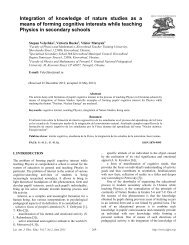
![Diversas formas de visualizar estados en un sistema cuántico [PDF]](https://img.yumpu.com/51151303/1/190x245/diversas-formas-de-visualizar-estados-en-un-sistema-cuantico-pdf.jpg?quality=85)

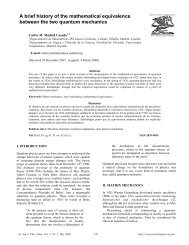
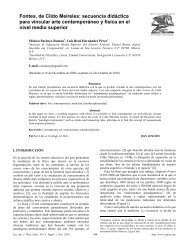
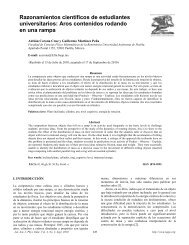

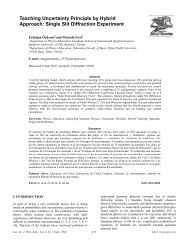
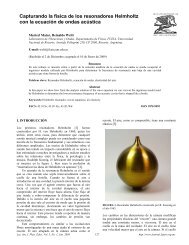
![Index [PDF] - Latin-American Journal of Physics Education](https://img.yumpu.com/47984121/1/190x245/index-pdf-latin-american-journal-of-physics-education.jpg?quality=85)
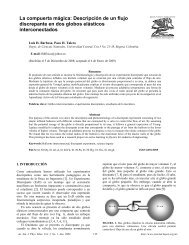
![Flujo de agua en botellas como experimento didáctico [PDF]](https://img.yumpu.com/43536300/1/190x245/flujo-de-agua-en-botellas-como-experimento-didactico-pdf.jpg?quality=85)
